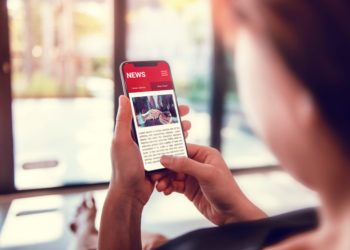This post is co-authored with Lindsay Chervinsky, PhD, a historian at the White House Historical Association and an expert in Early American history, the presidency, and the government – especially the president’s cabinet.
As David Crotty wrote earlier this week, Scholarly Kitchen posts for the last months suggest the powerful impact of COVID-19: eight of the top ten most read posts were directly pandemic-related. Every sector of scholarly communications — higher education, libraries, publishing, conferences, and more — is pivoting to virtual gathering and digital services. And in our daily working life most of us, even those of us already familiar with working remotely, are experiencing an intensification of videoconferencing.
How will this rapid acceleration of virtual experience and online programming affect promoting and simply getting together to talk about books? We are seeing a variety of approaches from publishers, organizations, and authors themselves. Some of these build on previous programs and some are all new.

With conferences canceled, postponed, or moved online, and with course adoptions in transition as classes move online, publishers are pursuing a variety of online adaptations. Since Karin talked with them last summer about the significance of e-books for university presses, we thought it would be great to ask Lisa Bayer, Director of the University of Georgia Press, and John Sherer, Director of the University of North Carolina Press about their virtual plans in response to COVID-19. Both presses are running ongoing discounts on their sites (50% at UGA Press, “Better than Bezos,” notes Bayer), for example. Both are also doing online exhibits to step in for exhibits at conferences, potentially coordinated with the conference hosts, and targeted at the conference participants and their field. Sherer noted that this is “potentially creating a long-term model for ‘appearing’ at conferences” that the press couldn’t always attend: “We no longer have a binary [of] going full force versus we can’t afford to go.” These exhibits, Bayer added, can feature both new books and “more backlist than we could send to a physical exhibit.” Feedback seems, said Sherer, “more than a little good.”
For organizations that host author events, going online can be a useful way to amplify or add to existing programming. Our inboxes and social media channels are full of book talks and presentations offering opportunities to hear from authors and learn about new books in particular. At Mount Vernon, for example, where like other museums and public history sites they are offering virtual tours and exhibits, livestream Book Talk Tuesdays are available on Mount Vernon’s social media channels, including Facebook, YouTube, and Twitter. These kicked off with Alexis Coe, author of the New York Times bestselling biography of George Washington, You Never Forget Your First. James Ambuske, who heads the Center for Digital History at the library at Mount Vernon and hosts the book talks, noted that these events are allowing “us to reach audiences far beyond Northern Virginia… from across the United States and even abroad.” Adding a Q&A to these events is developing greater engagement opportunities that may mean these kinds of events continue beyond the pandemic.
For authors whose books published since the first of the year, the disappointment over scuttled books talks and even book tours, and campus, conference, and big event appearances is real. Lindsay, whose book The Cabinet: George Washington and the Creation of an American Institution was published just weeks after the lockdown commenced in the DC metro area where she lives and works, launched an entirely new endeavor, the History Summit. This virtual event on April 25th brought together over two dozen authors of recently published books for a combination of author talks (recorded videos) and social media engagement.
Lindsay had a few rules for participants: they had to have a book come out in the first six months of 2020 (roughly) and they had to be on Twitter (the platform she designated for discussion). About 60% of participants were targeted invites (either friends or recommendations from friends). The remaining 40% were suggestions from Twitter or the author contacted Lindsay directly. Without paying for advertising, and using word of mouth and social media promotion by the participants, the event was quite successful.
We don’t know — or don’t typically share — how these new virtual platforms are functioning. But Lindsay shares this data to better inform how we might adapt and adopt this kind of event and promotion in the next months and years:
Website Statistics for the History Summit:
On April 25:
- 1885 visitors, 6,221 page views
- Source: 57% Twitter, 30% direct, 8% Facebook
- 59% mobile; 36% desktop
- heaviest online traffic between 9AM—2PM EDT
- “Buy Now” clicks for each author averaged around 5% conversion (although there is no way to track who visited Amazon or press sites directly)
Month of April:
- 584 “Buy Now” clicks for entire site, page with highest conversation rate per viewer was 8.2%
- 4,887 users, average user spent 3 minutes on the site, 14.6K page views
- April 25-26: 2.1K users, 3m 45s per visit
Twitter Reach:
- April 21-27: 1.2k conversations, 2k engagement, 788.2K potential reach
- April 24-30: 1.1K conversations, 1.9K engagement, 760.4K potential reach
We have focused on our home discipline, history, and our field, early American history in particular, to highlight some of the efforts at book promotion and author-reader and organizational engagement. This discipline and field already had a decent number of digital projects promoting books, including podcasts like New Books Network and Ben Franklin’s World (produced by the Omohundro Institute). The question is what we will carry forward from the era of COVID-19. Lindsay notes that a key feature of the History Summit was asynchronous content. Other organizations seem to agree. Making live content, with space for in-event Q&A, provides an opportunity for dynamic engagement. But recording and posting the content for anyone to access later expands the audience.
As we move through this challenging period there will be lots of developments to assess. Taking account of what virtual programming is working best for every feature of scholarly communications is going to be key. For publishing and marketing books these fresh sets of events and platforms will likely remain with us. An interesting question is whether they will be seen as adjacent or secondary to in-person events, or vice versa.



